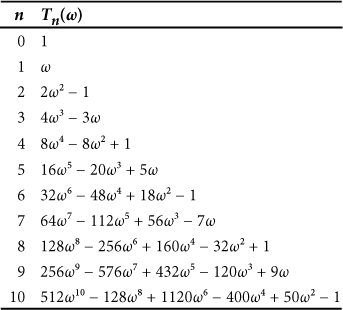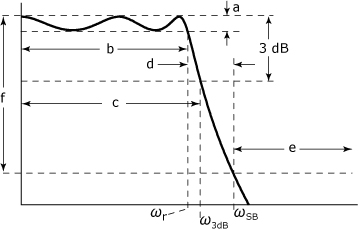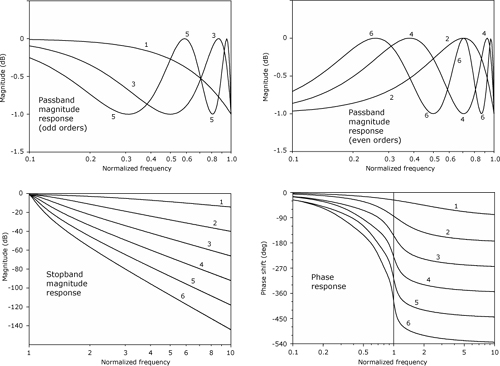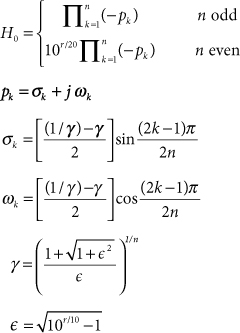Note 41. Chebyshev Filters
Chebyshev filters comprise one of the analog filter families that are commonly used as prototypes for IIR digital filters designed using either the impulse invariance method (Note 50) or the bilinear transformation (Note 51).
Alowpass Chebyshev filter is obtained as an equiripple approximation to the response of an ideal lowpass filter. This approximation yields a filter having a squared magnitude response given by
![]()
where
![]() 2 = 10r/20 –1
2 = 10r/20 –1
r = passband ripple
Tn(ω) = Chebyshev polynomial of order n
The first eleven Chebyshev polynomials are listed in Table 41.1. The table can be extended using the recurrence relation:
Tn+1(ω) = 2ωTn(w)–Tn–1(ω)
Table 41.1. Chebyshev Polynomials

Figure 41.1 shows the important features in the magnitude response for a Chebyshev lowpass filter. The response is most often presented in a form where the response is normalized to have a ripple bandwidth, ωr, equal to 1, because this form involves simpler calculations. However, comparison with other filter families is often easier when the magnitude response is normalized to have the 3-dB frequency ω3dB equal to 1. Design Procedure 41.1 can be used to renormalize a filter design from ωr = 1 to ω3dB = 1. The transfer function for an nth order Chebyshev LPF normalized for ωr = 1 is given in Math Box 41.1.
Figure 41.1. Magnitude response of a fifth-order Chebyshev filter. Features are: (a) ripple limits, (b) ripple bandwidth, (c) 3-dB bandwidth, (d) transition band, (e) stopband, and (f) stopband attenuation.

There are several different equations that can be used to estimate the minimum number of poles that are required for a Chebyshev lowpass filter to achieve a desired set of specifications. Two of the most commonly cited equations are from Rabiner and Gold [1]:
41.1


and from Van Valkenberg [2]:
41.2

These two equations provide similar, but not identical, results. It’s worth noting that the MATLAB help file for the function cheb1ord() cites Rabiner and Gold, but Eq. (41.2) is used for the actual implementation contained in cheb1ord.m.
Figure 41.2 shows the magnitude and phase responses for lowpass Chebyshev filters of orders 1 through 6.
Figure 41.2. Frequency response plots for lowpass Chebyshev filters of orders 1 through 6

References
1. L. R. Rabiner and B. Gold, Theory and Applications of Digital Signal Processing, Prentice Hall, 1975.
2. M. E. Van Valkenberg, Analog Filter Design, Oxford University Press, 1982.
3. A. Antoniou, Digital Filters: Analysis and Design, McGraw-Hill, 1979.




